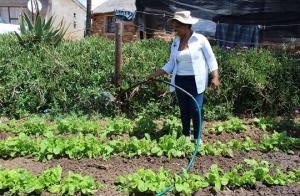Water tanks helping rural women in Lesotho withstand climate change
Access to water has relieved the women of the burden of collecting water far from their homes, and has increased farms production.

Mamothepane Khatseane irrigating her spinach garden in Quthing, Lesotho. ©FAO/Teopista Mutesi
Women in Lesotho are primarily responsible for collecting water for home use and for farming activities. The challenge of lack or limited water infrastructure coupled with the drying of water springs have meant that they must walk further, wait for longer and rely on lower quality water to provide for their household and farming.
“I used to walk a distance of 400 meters to collect water overflowing from the community storage tank. I would go there at least 20 times a day pushing a wheelbarrow especially during the dry season when the children are at school,” says Mamothepane Khatseane, a mother of four children, from Ha Koali village, Quthing district.
Climate change conditions such as erratic rains and droughts have increased in her area, and she has to adapt to continue with farming, and take care of her family.
In other areas, women collect water from unprotected overflow springs which provide low quality water and is shared with animals.
“The spring we fetched water was a far walk. I would leave home as early as 6 a.m. to fetch water, and would return around 9 a.m. Livestock would also drink from the same spring”, says Maliile Matete, from Boluma- Tau, Mafeteng, “There were constant conflicts between women fetching water and the livestock owners,” she added.
Learn more
